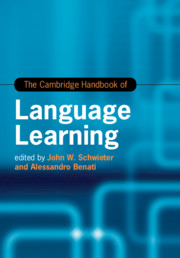Book contents
- The Cambridge Handbook of Language Learning
- Cambridge Handbooks in Language and Linguistics
- The Cambridge Handbook of Language Learning
- Copyright page
- Contents
- Figures
- Tables
- Contributors
- Acknowledgements
- Introduction
- Part I Theories
- Part II Methods
- Part III Skill Development
- Part IV Individual Differences
- Part V Pedagogical Interventions and Approaches
- Part VI Context and Environment
- 27 Bilingual Education and Policy
- 28 Heritage Language Instruction
- 29 Minority Languages at Home and Abroad: Education and Acculturation
- 30 Study Abroad and Immersion
- 31 Teacher Education: Past, Present, and Future
- Part VII Moving Forward
- Index
- References
31 - Teacher Education: Past, Present, and Future
from Part VI - Context and Environment
Published online by Cambridge University Press: 25 June 2019
- The Cambridge Handbook of Language Learning
- Cambridge Handbooks in Language and Linguistics
- The Cambridge Handbook of Language Learning
- Copyright page
- Contents
- Figures
- Tables
- Contributors
- Acknowledgements
- Introduction
- Part I Theories
- Part II Methods
- Part III Skill Development
- Part IV Individual Differences
- Part V Pedagogical Interventions and Approaches
- Part VI Context and Environment
- 27 Bilingual Education and Policy
- 28 Heritage Language Instruction
- 29 Minority Languages at Home and Abroad: Education and Acculturation
- 30 Study Abroad and Immersion
- 31 Teacher Education: Past, Present, and Future
- Part VII Moving Forward
- Index
- References
Summary
The preparation of teachers has a rich history as a critical topic in political and social circles in the United States of America and is currently in policymakers’ crosshairs. With more than 200 years in development, teacher education in the US has changed dramatically, which can be documented by four historical periods: Colonial to 1789; 1789 to 1860; 1860 to 1910; and 1910 forward (LaBue, 1960). This chapter begins by presenting a historical perspective of the US teacher preparation system focusing on aspects such as who controlled teacher education and teacher credentialling as well as how the past seventy years have been impacted by four questions driving educational reform with an emphasis on the teaching of languages. After, the chapter highlights the teacher preparation system in Finland, extolled globally for outstanding student achievement. Subsequent to that, it turns to discuss the current landscape of the American teacher education system and juxtaposes it against its history over the past 200 plus years and the success of the Finnish system of preparing teachers.
- Type
- Chapter
- Information
- The Cambridge Handbook of Language Learning , pp. 751 - 774Publisher: Cambridge University PressPrint publication year: 2019



